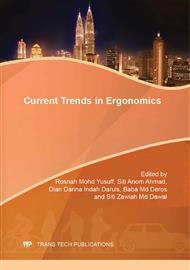[1]
Modjo, Robiana. Keselamatan dan kesehatan kerja, siapa perduli?. Februari 9, 2012. http: /staff. ui. ac. id/internal/132096019/publikasi/ArtikelK3 SiapaPerduliRobianaModjo. pdfhttp: /staff. ui. ac. id/internal/132096019/publikasi/ArtikelK3 SiapaPerduliRobianaModjo. pdf. (2007).
Google Scholar
[2]
Wickens, C.D., Gordon, S.E., Liu, Y. A Introduction to Human Factors Engineering. Longman, New York. (1998).
Google Scholar
[3]
Ayoub, M.M., Mital, A. Manual materials handling. London: Taylor and Francis. (1989).
Google Scholar
[4]
Ramadha, Krisna Angga. Analisis Ergonomi para Buruh Angkut Terhadap Terjadinya Keluhan Musculoskeletal Disorders (MSDs) Menggunakan NIOSH Lifting Equation dan PEI. Depok: Universitas Indonesia. (2010).
Google Scholar
[5]
Astuti, R. D., Suhardi, B. Analisis Postur Kerja Manual Material Handling Menggunakan Metode OWAS (Ovako Work Posture Analysis System). Gema Teknik: Majalah Ilmiah Teknik Vol. 10, No. 1. (2007).
DOI: 10.33479/snti.v1i.191
Google Scholar
[7]
Swei-Pi, Wu. Psychophysically Determined Symmetric and Asymmetric Lifting Capacity of Chinese Males for One Hour's Work Shifts. Elsevier: International Journal of Industrial Ergonomics 25, 675-682. (1999).
DOI: 10.1016/s0169-8141(99)00055-4
Google Scholar
[8]
Kwan S. Lee *, Hee S. Park, Young H. Chun. The Validity of the Revised NIOSH Weight Limit in a Korean Young Male Population: A Psychophysical Approach. Elsevier: International Journal of Industrial Ergonomics 18, 181 – 186. (1996).
DOI: 10.1016/0169-8141(95)00081-x
Google Scholar
[9]
NIOSH (National Institute of Occupational Safety and Health). Work Practices Guide for Manual Lifting. DHHS (NIOSH) Publication No. 81, 122, Cincinnati, OH. (1981).
DOI: 10.1016/s1074-9098(99)00094-5
Google Scholar
[10]
Waters, et al. Revised NIOSH Equation for the Design and Evaluation of Manual Lifting Tasks. Journal of Ergonomics Vol. 36 No. 7. (1993).
DOI: 10.1080/00140139308967940
Google Scholar
[11]
Waters, et al. Accuracy of Measurement for the Revised NIOSH Lifting Equation. Elsevier: Applied ergonomics Vol. 29 No. 6. (1997).
Google Scholar
[12]
Swei-Pi, Wu. Maximum acceptable weight of lift by Chinese experienced male manual handlers. Elsevier: Applied Ergonomics 28, pp.237-244. (1997).
DOI: 10.1016/s0003-6870(96)00080-4
Google Scholar
[13]
Zhu, Z., Zhang, Z. Maximum Acceptable Repetitive Lifting Workload by Chinese Subjects. Ergonomics 33, 875–884. (1990).
DOI: 10.1080/00140139008925295
Google Scholar
[14]
Evans, W.A. The Relationship between Isometric Strength of Cantonese Male and the US NIOSH Guide for Manual Lifting. Applied Ergonomics 21, 135–142. (1990).
DOI: 10.1016/0003-6870(90)90136-l
Google Scholar
[15]
Maiti, R; Ray, G.G. Determination of Maximum Acceptable Weight of Lift by Adult Indian Female Workers. International Journal of Industrial Ergonomics 2004-01-01. (2004).
DOI: 10.1016/j.ergon.2004.06.003
Google Scholar
[16]
Mital, A., & Ramakrishnan, A. A Comparison of Literature-Based Design Recommendations and Experimental Capability Data for a Complex Manual Materials Handling Activity. International Journal of Industrial Ergonomics, 24, 73–80. (1999).
DOI: 10.1016/s0169-8141(98)00089-4
Google Scholar
[17]
Widyanti; Ari. Analisis manual material handling serta faktor pengali vertikal dan jarak DM pada persamaan pembebanan NIOSH. Bandung: Institut Teknologi Bandung. (1998).
Google Scholar
[18]
Bloswick, D. S. Estimation of Stresses Associated with Manual Material Handling Tasks: Back Compressive Force. Juni 10, 2012. http: /personal. health. usf. edu/tbernard/HollowHills/UtahBackCompForc11. pdfhttp: /personal. health. usf. edu/tbernard/HollowHills/UtahBackCompForc11. pdf. (2000).
Google Scholar


